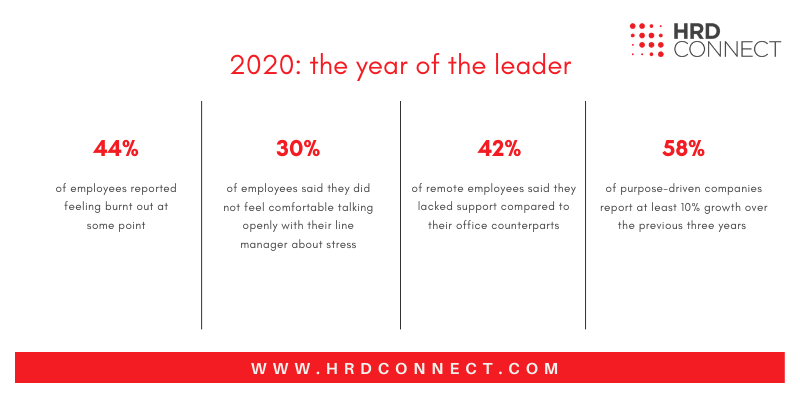HRD Deep Dive: Leadership priorities in the new world of work
- 6 Min Read
Transitioning and responding to this year’s disruption has been a minefield for organizations, and as a result, it’s difficult to know what your key focus points should be. This is particularly true when it comes to leadership, so in this week’s HRD Deep Dive, we take a closer look at some crucial areas for leaders to keep in mind in the coming months.
- Author: Sam Alberti
- Date published: Sep 10, 2020
- Categories

From branding to internal processes to HR strategy, almost every core component of a typical organization has changed in some way in 2020. ‘Pivot’ is a word that has come to define modern business, and a company’s ability to execute this successfully has almost become a barometer for its competence and integrity.
But as the objectives and goals of an organization changes, so too does the role of leadership. Traditionally, a leader must take a series of calculated measures on a daily basis to ensure that the organization moves in the right direction – but crucially, these measures are changing with the times.
As a result, leaders must now rethink their priorities in order to align with the direction of the organization, and ensure maximum productivity and success.
Despite being an expansive topic, we’ve highlighted our top priorities for leadership in 2020 and beyond.
Purpose and progress
As the notion of ‘careerism’ gradually falls by the wayside and work becomes more vocational, the need for organizations to offer a strong, defined sense of purpose to employees is real and immediate.
This naturally becomes more prominent as a broader range of generations enter the workplace. One study even found that 88% of millenials want to work for an organization whose values reflect their own.
What’s more, just 7% of Fortune 500 CEOs believe that their companies should focus solely on profit and avoid being distracted by social goals.
But this need has intensified even further since the pandemic, with the eyes of customers, investors and employees all firmly fixed on how organizations have dealt with the transition period.
Aberdeenshire-based brewing and distilling company BrewDog, for instance, is an organization that has executed this seamlessly Its leadership has succeeded in keeping employees engaged by displaying a clear sense of care and compassion whilst maintaining its rigid stance on social consciousness.
And in terms of the wider impact this could have on the organization, the sky appears to be the limit. For instance, over half (58%) of purpose-driven companies report at least 10% growth over the previous three years.
A similar principle applies when it comes to the prospect of growth and development for the individual. Again, the notion of a career is becoming more and more disparate from the concept of making money, and as a result, progress is much higher on the agenda.
Deloitte explored this in its 2020 Talent Report, finding that 37% of employees who were planning to switch companies cited lack of career progress as the primary reason.
In sum, it’s crucial that in 2020, employees are not viewed simply as commodity items. Not only must the organization attune itself to the needs and sensibilities of the majority, but crucially, leadership teams must communicate these principles on a regular basis.

Caring and compassionate leadership
“Leaders can make a difference through personal accountability, caring, and ‘re-onboarding‘ all of their people,” reads a McKinsey article from earlier this year on leadership agendas in troubled times. And for many modern organizations, this should ring true.
In fact, this ties in nicely with our previous topic. Much like the notion of purpose, the importance of caring and compassionate leadership is something that has grown with each passing generation, and now constitutes a staple element of modern business.
Our understanding of phenomenons such as burnout has grown, and as a result leaders are able to implement measures to mitigate the impact.
For instance, a Gallup study found that 44% of employees reported feeling burnt out at some point, and another found that, among physicians, $4.6bn in costs is amassed each year in the United States as a result of burnout and turnover. The knock-on effect this could have on productivity and organizational success is self-explanatory.
These are alarming figures in their own right, but when we factor in the health (and arguably, mental health) crisis we currently face, the need for action becomes even more apparent.
With the anxiety and uncertainty of returning to a co-located working space, the financial harm that COVID-19 has brought about in many scenarios, and the added mental strain that workers have been experiencing due to undergoing numerous transition phases, the risk is now greater than ever before.
This is why leaders, now more than ever before, should take the opportunity to establish a culture of care, compassion and empathy within the organization.
Maintaining company culture through leadership
The importance of creating a healthy, engaging company culture is not an unfamiliar concept in 2020. However, with coronavirus sending many organizations spiraling into rapid and unexpected transitions, maintaining this culture is where the difficulty lies.
In fact, this difficulty is all but proven, with figures showing that just 55% of remote employees feel like they are part of a team, and 42% of remote workers saying they lack daily support compared to their office counterparts.
What’s more, the damage this could cause has the potential to be significant and costly. Research shows that disaffected workers cost American businesses roughly $450 to $550 billion each year in lost productivity.
Further research found that of 1,000 HR leaders, an overwhelming 84% agreed that culture is critical for business success, and 60% agreed that culture is more important than strategy or the business model.
And during a time where many organizations are feeling the full force of a struggling economy, the knock-on effects of company culture on organizational success are more significant than ever before.
One study even found that more than 50% of executives agree that culture drives workplace productivity, and another conducted earlier this year shows that 83% of executives see culture playing a far greater role in sustaining a thriving workforce in a post-COVID world.
Based on this, leadership teams must strive to be conduits for company culture, ensuring that the company vision and ethos is clearly communicated and that their teams feel the full benefit of this.









